
A telephoto lens, also known as telelens, is a specific type of a long-focus lens used in photography and cinematography, in which the physical length of the lens is shorter than the focal length. This is achieved by incorporating a special lens group known as a telephoto group that extends the light path to create a long-focus lens in a much shorter overall design. The angle of view and other effects of long-focus lenses are the same for telephoto lenses of the same specified focal length. Long-focal-length lenses are often informally referred to as telephoto lenses, although this is technically incorrect: a telephoto lens specifically incorporates the telephoto group.
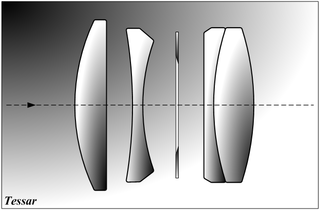
The Tessar is a photographic lens design conceived by the German physicist Dr. Paul Rudolph in 1902 while he worked at the Zeiss optical company and patented by Zeiss in Germany; the lens type is usually known as the ZeissTessar. Since its introduction, millions of Tessar and Tessar-derived lenses have been manufactured by Zeiss and other manufacturers, and are still produced as excellent intermediate aperture lenses.

Minolta Co., Ltd. was a Japanese manufacturer of cameras, camera accessories, photocopiers, fax machines, and laser printers. Minolta Co., Ltd., which is also known simply as Minolta, was founded in Osaka, Japan, in 1928 as Nichi-Doku Shashinki Shōten. It made the first integrated autofocus 35 mm SLR camera system. In 1931, the company adopted its final name, an acronym for "Mechanism, Instruments, Optics, and Lenses by Tashima".

TC-1 is a luxury point and shoot camera that was produced by Minolta. It is a compact 35 mm clad in titanium, equipped with a G-Rokkor 28mm f/3.5 lens. The TC-1 was equipped with a high quality lens and body, similar to other luxury compacts produced during the Japanese bubble economy era, including the Contax T line, Konica Hexar, Leica minilux, Nikon 28/35Ti, Ricoh GR series, and Rollei QZ 35W/35T. Expensive when initially released in 1996 with a suggested retail price of ¥148,000, it was produced in small numbers and since then has become collectible.

A catadioptric optical system is one where refraction and reflection are combined in an optical system, usually via lenses (dioptrics) and curved mirrors (catoptrics). Catadioptric combinations are used in focusing systems such as searchlights, headlamps, early lighthouse focusing systems, optical telescopes, microscopes, and telephoto lenses. Other optical systems that use lenses and mirrors are also referred to as "catadioptric", such as surveillance catadioptric sensors.
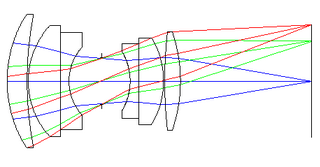
The double Gauss lens is a compound lens used mostly in camera lenses that reduces optical aberrations over a large focal plane.
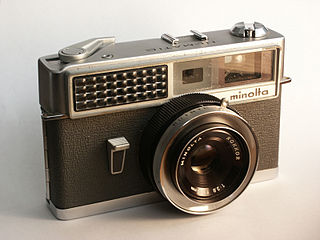
Hi-Matic was the name of a long-running series of 35 mm cameras made by Minolta. The original Hi-Matic of 1962 was the first Minolta camera to feature automatic exposure and achieved a small degree of fame when a version was taken into space by John Glenn in 1962.

In photography, soft focus is a lens flaw, in which the lens forms images that are blurred due to uncorrected spherical aberration. A soft focus lens deliberately introduces spherical aberration which blurs fine texture in the image while retaining sharp edges across areas of high contrast; it is not the same as an out-of-focus image, and the effect cannot be achieved simply by defocusing a sharp lens. Soft focus is also the name of the style of photograph produced by such a lens.

The EF 85mm lenses are a group of medium telephoto prime lenses made by Canon Inc. that share the same focal length. These lenses have an EF type mount that fits the Canon EOS line of cameras.
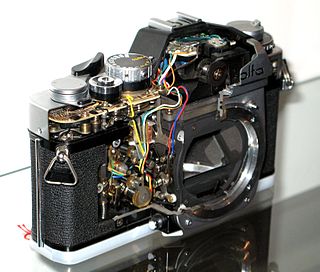
The Minolta SR-mount was the bayonet mounting system used in all 35 mm SLR cameras made by Minolta with interchangeable manual focusing lenses. Several iterations of the mounting were produced over the decades, and as a result, the mount itself was sometimes referred to by the name of the corresponding lens generation instead.
The design of photographic lenses for use in still or cine cameras is intended to produce a lens that yields the most acceptable rendition of the subject being photographed within a range of constraints that include cost, weight and materials. For many other optical devices such as telescopes, microscopes and theodolites where the visual image is observed but often not recorded the design can often be significantly simpler than is the case in a camera where every image is captured on film or image sensor and can be subject to detailed scrutiny at a later stage. Photographic lenses also include those used in enlargers and projectors.
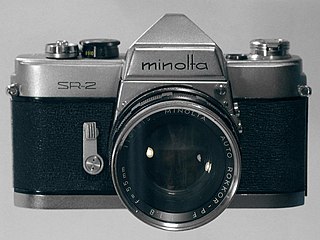
The Minolta SR-2 was presented in 1958 as the first 35mm SLR camera from Chiyoda Kogaku. Popular cameras of this type at that time were mainly from Europe but a few from Japan, including the Asahi Pentax, the Miranda T and the Topcon R. The miniature SLR camera concept was conceived in the 1930s at Ihagee in Dresden, resulting in the 1936 Kine Exakta. Influential cameras designs like that of the 1939 KW Praktiflex, the 1949 ZI Contax S, and 1952 the KW Praktina marked the steady progress toward a perfected SLR. Several features of the latter seem to have influenced the design of the SR-2 although dissimilar in many respects. The obvious similarities are the stepped top plate, the carrying strap lugs, the self-timer lever and some general body features.

Biogon is the brand name of Carl Zeiss for a series of photographic camera lenses, first introduced in 1934. Biogons are typically wide-angle lenses.

The invention of the camera in the early 19th century led to an array of lens designs intended for photography. The problems of photographic lens design, creating a lens for a task that would cover a large, flat image plane, were well known even before the invention of photography due to the development of lenses to work with the focal plane of the camera obscura.

Rokkor was a brand name used for all Chiyoda Kōgaku Seikō and later Minolta lenses between 1940 and 1980, including a few, which were marketed and sold by other companies like Leica. The name was derived from the name of Rokkō (六甲山), a 932 metre (3058') high mountain, which could be seen from the company's glass-making and optics factory at Mukogawa near Osaka, Japan. The company's founder Kazuo Tashima wanted the name to symbolize the high quality in optics.

The Sony FE 85mm F1.4 GM is a premium short telephoto full-frame prime lens for the Sony E-mount, released by Sony on February 3, 2016.

The Fish-Eye Rokkor 16mm f/2.8 is a prime fisheye lens produced by Minolta for Minolta SR-mount single lens reflex cameras, introduced in 1969 to replace an earlier fisheye lens, the UW Rokkor 18mm f/9.5. It is a full-frame fisheye lens with a 180° viewing angle across the diagonal.

The UW Rokkor 18mm f/9.5 is a prime fisheye lens produced by Minolta for Minolta SR-mount single lens reflex cameras, introduced in 1966 as the system's first fisheye lens. It is a full-frame fisheye lens with a 180° viewing angle across the diagonal, and was replaced when the Minolta Fish-Eye Rokkor 16mm f/2.8 lens was released in 1969.

















